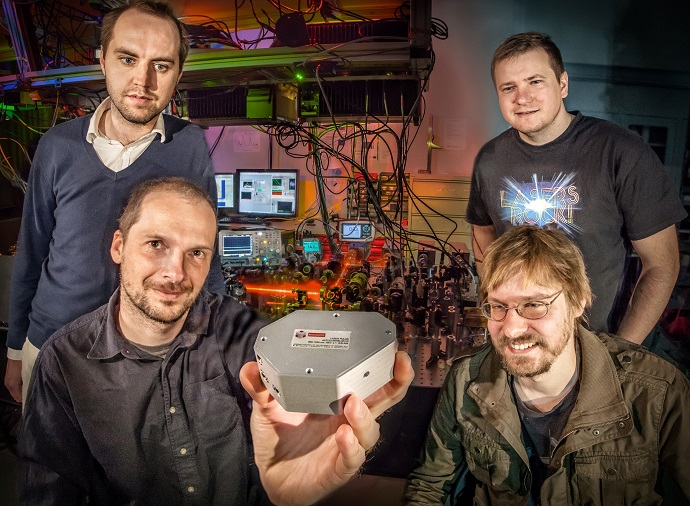23 September 2015
Today’s lasers generating ultrashort light pulses require major and complex optical systems that measure pulse parameters or tune their wavelength. As part of the EU MINIMODS project, the Faculty of Physics at the University of Warsaw has achieved significant miniaturisation of laser diagnostics systems. The achievement paves the way for industrial production of femtosecond lasers with a compact construction that are reliable and potentially capable of self-calibration.
Lasting just a millionth of a billionth of a second, the unimaginably short, femtosecond-long laser pulses have many applications in modern industry. But existing lasers that generate them have a significant drawback: they require large, complex and sensitive external optical systems for diagnosing and processing the pulses. Optics specialists from the Institute of Experimental Physics at the Faculty of Physics of the University of Warsaw have successfully miniaturised some of these systems. The innovative instruments, made as part of the EU MINIMODS project with a budget of €1.5 million, are cheap and easy to produce, even on a mass scale.
“We haven’t reinvented the wheel, but rather we have applied our existing knowledge. As a result, we have been able to reduce the size of crucial optical equipment literally to millimetres. Such tiny diagnostic instruments can be permanently integrated with pulse lasers, which will be able to tune themselves,” explains Piotr Wasylczyk, PhD, MINIMODS Principal Investigator from the Photonic Nanostructure Facility (PNaF), part of the Division of Optics in the Institute of Experimental Physics.
The MINIMODS project (MINIaturised MODuleS) forms a part of the Research for SMEs package of the European Commission’s 7th Framework Programme encouraging scientific institutions to implement research projects commissioned by enterprises within the EU. The industrial side of MINIMODS is formed by four companies: M Squared Lasers from Scotland, LASEROPTIK from Germany, Time-Bandwidth Products from Switzerland (currently JDSU Ultrafast Lasers), and Radiantis Light from Spain. They are leading producers of narrow- and wideband sapphire lasers, lasers generating ultrashort (pico- and femtosecond) pulses, systems for laser frequency conversion, and advanced optical coatings. The project is coordinated by M Squared Lasers from Glasgow.
The optical instruments modernised by physicists from the University of Warsaw as part of MINIMODS include an autocorrelator and a tripler – a device for modifying light frequency.
The autocorrelator is an important component of pulse lasers, since it monitors the duration of individual pulses. The miniaturisation of the device whose first versions have been designed and tested at the Faculty of Physics before the MINIMODS project was commenced will make it possible to integrate it with the laser head itself. Thus improved laser, with its own diagnostic system, will be able to constantly monitor the pulse duration, and in the event of deviation from assumed values, it will automatically calibrate accordingly.
The miniaturisation of the tripler – a system for generating higher harmonics – posed some fascinating challenges. The systems are used when it is necessary to reduce the wavelength of light pulses to a spectral range that cannot be generated directly in the laser. An example are ultrashort UV pulses, which are especially applicable in material processing. However, lasers that directly generate UV light simply do not exist.
Physicists from the Institute have developed a device reducing the wavelength of laser pulses from approx. 1000 nanometres to the UV range of 370 nm. To achieve this, the laser pulse was first passed through a non-linear crystal, which halved the wavelength to generate a seconda harmonic in the green region of the spectrum. To generate the third harmonic, both pulses – the infrared and the green – had to then be combined in another crystal. However, how can this be achieved when the fundamental and second harmonic pulses propagate in different directions and at different speeds? Advanced computer simulations led to designing a set (“sandwich”) of three crystals, which were placed between crystals generating the harmonics to ensure both pulses are superimposed on one another in time and space. It was eventually possible to reduce the system of five crystal plates to the size of a cube with a side of just 5 mm. Another benefit was the increase of the efficiency of the device by 50% in comparison to similar equipment used today.
It would have been impossible to implement the MINIMODS project at the Faculty of Physics without advanced software for modelling non-linear propagation of light pulses, developed by Warsaw researchers.
“In nonlinear optics, computer simulations are generally conducted in two dimensions: one temporal, one spatial. The result is a curve whose values have to be adjusted to match experimental data. With our software we are able to propagate a tightly focused virtual laser pulse through as many as five different crystals, simulating its non-linear propagation in space and in three spatial dimensions. What’s more, the program gives us absolute parameter values, which match very well the experimental data,” stresses Tomasz Kardaś, PhD, Senior Researcher responsible for the light propagation software package development.
The Faculty of Physics was joined in the MINIMODS project by the Fraunhofer Centre for Applied Photonics in Scotland. Scottish researchers miniaturised two other optical diagnostic systems for femtosecond lasers: a spectrometer, and a device for measuring the laser beam quality.
MINIMODS is the first scientific research programme implemented at the University of Warsaw on commission from small and medium enterprises from the EU member states.
“We are delighted that we were able to find a way to take our knowledge directly from the optics lab to the European laser industry,” says Dr. Wasylczyk.
This research has received funding from the European Union Seventh Framework Programme (FP7/2007-2013) under grant agreement no. 606141 (MINIMODS, "Miniaturised diagnostics and frequency-conversion modules for ultrafast lasers").
http://www.minimods.eu/
The website of the MINIMODS project.












